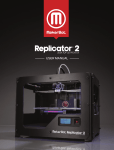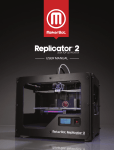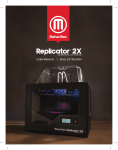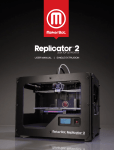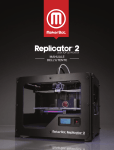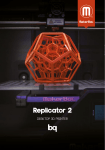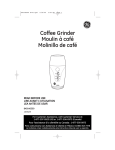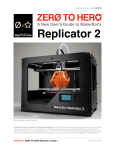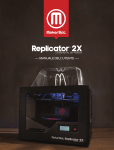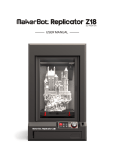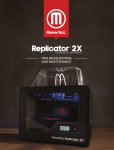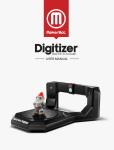Download USER MANUAL - downloads
Transcript
® USER MANUAL MB2020_REP2_UserManual_V4.indd 1 7/22/13 5:32 PM MB2020_REP2_UserManual_V4.indd 2 7/22/13 5:32 PM TABLE OF CONTENTS A WELCOME. LET’S GET STARTED Specifications How Does it Work? 04 06 07 B SETTING UP YOUR MAKERBOT REPLICATOR 2 DESKTOP 3D PRINTER What’s in The Box MakerBot Replicator 2 Diagram Unpacking Your MakerBot Replicator 2 Installing Build Plate Installing Filament Guide Tube and Spool Holder Mounting Filament Spool and Attaching USB Cable Attaching Power Supply and Powering On 08 10 11 12 14 15 16 17 C STARTUP PROCESS: LEVELING, LOADING, TESTING Leveling the Build Plate Loading MakerBot PLA Filament Unloading MakerBot PLA Filament Making a Test Object from the SD Card 18 20 23 27 28 D MAKING AN OBJECT WITH MAKERBOT MAKERWARE 30 E TROUBLESHOOTING, DIAGNOSTICS, AND MAINTENANCE Troubleshooting Diagnostics LCD Panel | Top-Level Menu LCD Panel | Utilities Menu LCD Panel | Info and Settings Menu Maintenance Lubricating the Threaded Rod and the X-Axis Idler Pulley Cleaning the Drive Gear Glossary of Terms Contact Us Safety and Compliance Warranty, Returns, and Replacement Policy 42 44 46 46 47 48 49 49 51 54 56 57 58 F TERMS OF SERVICE 58 V4 MB2020_REP2_UserManual_V4.indd 3 TABLE OF CONTENTS 3 7/22/13 5:32 PM A Welcome. Let’s get started. MB2020_REP2_UserManual_V4.indd 4 7/22/13 5:32 PM This User Guide is designed to start your journey with the MakerBot® Replicator ®2 Desktop 3D Printer in the right direction. Even if you are familiar with earlier MakerBot machines, it is essential that you read through this guide, as there are several important and exciting updates with the MakerBot Replicator 2. In chapters A and B, you will learn the basics of the MakerBot Replicator 2, how to unbox safely, and how to get set up. Chapters C–E will take you through leveling, printing, maintenance, and troubleshooting. MakerBot is excited to welcome you to the world of the MakerBot Replicator 2. Following this guide will help ensure that you are getting the most out of your machine, and that you continue to make amazing things. WARNING: The MakerBot Replicator 2 generates high temperatures and includes moving parts that can cause injury. Never reach inside the MakerBot Replicator 2 while it is in operation. Always allow the MakerBot Replicator 2 to cool down before reaching inside. WARNING: Do not leave the MakerBot Replicator 2 unattended during operation. CAUTION: If opening the MakerBot Replicator 2 for service, ensure that the power supply is turned off and the cord is disconnected. A WELCOME, LET’S GET STARTED MB2020_REP2_UserManual_V4.indd 5 5 7/22/13 5:32 PM SPECIFICATIONS PRINTING PHYSICAL DIMENSIONS Print Technology: Fused Filament Fabrication Without Spool: 19.1 x 12.8 x 14.7 in [49 x 32 x 38 cm] Build Volume: 11.2 L x 6.0 W x 6.1 H in [28.5 x 15.3 x 15.5 cm] With Spool: 19.1 x 16.5 x 14.7 in [49 x 42 x 38 cm] Shipping Box: 23 x 21.5 x 17 in [59 x 55 x 43 cm] Layer Resolution Settings: High 100 microns [0.0039 in] Weight: Standard 200 microns [0.0078 in] Shipping Weight: Low 300 microns [0.0118 in] Positioning Precision: XY: 11 microns [0.0004 in]; Z: 2.5 microns [0.0001 in] Filament Diameter: 1.75 mm [0.069 in] Nozzle Diameter: 0.4 mm [0.015 in] 25.4 lbs [11.5 kg] 37 lbs [16.8 kg] TEMPERATURE Ambient Operating 15° – 32° C [60° – 90° F] Temperature: Storage Temperature: 0° – 32° C [32° – 90° F] SOFTWARE Software Bundle: MakerBot MakerWare™ File Types: .stl, .obj, .thing Supports: Windows (XP 32 bit/7+) Ubuntu Linux (12.04+) Mac OS X (10.6 64 bit/10.7+) ELECTRICAL AC Input: 100 – 240 V, ~2 amps, 50 – 60 Hz Power Requirements: 24 V DC @ 6.25 amps Connectivity: SD card [FAT 16, max. 2GB] MECHANICAL 6 Chassis: Powder-coated steel Body: PVC Panels Build Platform: Acrylic XYZ Bearings: Wear-resistant, oil-infused bronze Stepper Motors: 1.8° step angle with 1/16 micro-stepping A WELCOME, LET’S GET STARTED MB2020_REP2_UserManual_V4.indd 6 7/22/13 5:32 PM HOW DOES IT WORK? The MakerBot Replicator 2 makes solid, three-dimensional objects out of melted MakerBot PLA Filament. Your 3D design files are translated into instructions for the MakerBot Replicator 2 and sent to the machine via SD card. Then the MakerBot Replicator 2 heats the MakerBot PLA Filament and squeezes it out through a nozzle to make a solid object layer by layer. This method is called Fused Filament Fabrication [FFF]. ® A WELCOME, LET’S GET STARTED MB2020_REP2_UserManual_V4.indd 7 7 7/22/13 5:32 PM B Setting Up Your MakerBot Replicator 2 Desktop 3D Printer ® MB2020_REP2_UserManual_V4.indd 8 ® 7/22/13 5:32 PM When you set up your MakerBot® Replicator ®2 Desktop 3D Printer, remember that it was built and packaged very carefully at the MakerBot factory. We hope you’ll take your time and be just as careful unpacking it and getting it set up. NOTE: Do not force or tear anything during unpacking and setup. This may damage the MakerBot Replicator 2 Desktop 3D Printer. B SETTING UP YOUR MAKERBOT REPLICATOR 2 DESKTOP 3D PRINTER MB2020_REP2_UserManual_V4.indd 9 9 7/22/13 5:32 PM WHAT’S IN THE BOX * 1 1 MakerBot PLA Filament [1lb Spool] 1 Filament guide tube Spool holder * 1 1 Build plate 4 1 Hex wrenches * 10 Power supply and cable PTFE-based grease 1 USB-A to USB-B cable 1 Support card 1 SD card 3 Blue tape sheets More options available at makerbot.com/store B SETTING UP YOUR MAKERBOT REPLICATOR 2 DESKTOP 3D PRINTER MB2020_REP2_UserManual_V4.indd 10 7/22/13 5:32 PM MAKERBOT REPLICATOR 2 DIAGRAM [1] GANTRY SYSTEM [2] LCD PANEL 1 2 [3] KEY PAD [4] THREADED Z-AXIS ROD [5] BUILD PLATE [6] BUILD PLATFORM 4 [7] FILAMENT GUIDE TUBE [8] EXTRUDER CABLE 5 6 [9] EXTRUDER 3 [10] FILAMENT SPOOL ® [11] SPOOL HOLDER 8 7 10 9 11 B SETTING UP YOUR MAKERBOT REPLICATOR 2 DESKTOP 3D PRINTER MB2020_REP2_UserManual_V4.indd 11 11 7/22/13 5:32 PM UNPACKING YOUR MAKERBOT REPLICATOR 2 1 Opening the Box 1 1a. Place the MakerBot Replicator 2 box on the ground. Open the box and remove the top cardboard sheet. 1b. Remove the MakerBot Replicator 2 User Manual. We recommend that you use the manual to guide you through the setup process and keep it at hand as you unpack the contents of the box. If you find that anything described in the manual is missing, email us at [email protected]. 1c. Remove the layer of foam and the sheet of cardboard underneath. 1d. Remove the two protective foam pieces from the sides of the Replicator 2. NOTE: You can download a PDF copy of this manual at makerbot.com/support/replicator2. 12 B SETTING UP YOUR MAKERBOT REPLICATOR 2 DESKTOP 3D PRINTER MB2020_REP2_UserManual_V4.indd 12 7/22/13 5:32 PM UNPACKING YOUR MAKERBOT REPLICATOR 2 2 CONTINUED Removing the MakerBot Replicator 2 from the Box 2a. Open the plastic covering and firmly grasp the frame of the MakerBot Replicator 2 from the outside. Lift it out of the box and place it on a stable surface. NOTE: The black cable is not a handle. Do not pull or twist the black cable at any time. 3 Removing the Accessory Box 1 3a. Remove the two remaining protective foam pieces from the bottom of the Replicator 2’s box. 3b. Lift out the accessory box. This box contains the remaining items from the “What’s in the Box” section. NOTE: Your MakerBot Replicator 2 should now be fully unpacked. We recommend that you keep the box and foam inserts in case you need to transport your MakerBot Replicator 2 in the future. B SETTING UP YOUR MAKERBOT REPLICATOR 2 DESKTOP 3D PRINTER MB2020_REP2_UserManual_V4.indd 13 13 7/22/13 5:32 PM INSTALLING BUILD PLATE 4 Installing the Build Plate 4a. Locate and unwrap the build plate. Tilt and fit the notch in the build plate onto the tab at the back of the build platform. Fit the tab in the build plate between the two pegs at the front of the build platform. 4b. To remove the build plate, gently push the tab on the front of the build plate toward the back of the build platform to release the tab from the pegs. Lift the build plate from the build platform. Plate-Locking Pegs 5 Freeing the Extruder 5a. Use strong scissors or a wire cutter to cut the zip ties holding the gantry system in place. Discard the zip ties and the plastic pieces holding them in place. NOTE: Operate scissors with care. 14 5b. A small plastic piece attached to the X-axis belt and gantry rods prevents the extruder from moving. Carefully snap the piece off of the rods and tilt it to slide it off of the belt. B SETTING UP YOUR MAKERBOT REPLICATOR 2 DESKTOP 3D PRINTER MB2020_REP2_UserManual_V4.indd 14 7/22/13 5:32 PM INSTALLING FILAMENT GUIDE TUBE AND SPOOL HOLDER 6 Installing the Filament Guide Tube 6a. Locate the filament guide tube. Insert one end into the hole at the top of the extruder and push the tube in as far as it will go. 6b. Insert the other end of the filament guide tube into the left guide tube holder [when viewed from the back] on the back of the MakerBot Replicator 2. Make sure that the end of the filament guide tube is flush with the bottom of the guide tube holder. The filament guide tube should not hang down past the bottom of the guide tube holder. 7 Installing the Spool Holder 7a. Locate the spool holder. Tilt the spool holder and insert the square end into the left side opening on the back of the MakerBot Replicator 2 [when viewed from the back]. B SETTING UP YOUR MAKERBOT REPLICATOR 2 DESKTOP 3D PRINTER MB2020_REP2_UserManual_V4.indd 15 15 7/22/13 5:32 PM MOUNTING FILAMENT SPOOL AND ATTACHING USB CABLE 8 Mounting the Filament Spool 8a. Open the box containing the MakerBot PLA Filament. Remove the spool from its bag. 8b. Fit the spool onto the spool holder. Ensure that the MakerBot PLA Filament unwinds counterclockwise [when viewed from the back] . Squeeze the spool holder and push the spool on until it locks. 9 Spool Holder Attaching the Power Supply 9a. Locate the power supply and cable. Attach the cable to the power supply. 9b. Ensure that the power switch on the MakerBot Replicator 2 is set to the OFF position. 9c. Insert the power supply connector into the power input on the back of the Replicator 2. Ensure that the flat side of the connector faces down. Power Supply 16 B SETTING UP YOUR MAKERBOT REPLICATOR 2 DESKTOP 3D PRINTER MB2020_REP2_UserManual_V4.indd 16 7/22/13 5:32 PM ATTACHING POWER SUPPLY AND POWERING ON 10 Powering On the MakerBot Replicator 2 10a. Plug the AC power cord into an electrical outlet. 10b. Set the power switch to the ON position. 10c. The MakerBot Replicator 2 will display welcome text on the LCD panel. This is the beginning of the startup script that will guide you through initial calibration and your first build. CAUTION: Do not use an extension cord or power supply other than the ones shipped with your MakerBot Replicator 2. Ensure that the plug is easily accessible in case the Replicator 2 needs to be disconnected. B SETTING UP YOUR MAKERBOT REPLICATOR 2 DESKTOP 3D PRINTER MB2020_REP2_UserManual_V4.indd 17 17 7/22/13 5:32 PM C Startup Process: Leveling, Loading, Testing MB2020_REP2_UserManual_V4.indd 18 7/22/13 5:32 PM After you power on the MakerBot® Replicator ®2 Desktop 3D Printer, the LCD panel will light up and display text. The LCD panel will now run the Startup Script. The Startup Script will guide you through leveling the build plate, loading MakerBot PLA Filament, and creating your first build. THE LCD KEYPAD • Four arrow buttons surround a central M button. Use the arrows to navigate through the LCD menus and make selections. • The left arrow usually allows you to go back or cancel an action. • A solid red M means the MakerBot Replicator 2 is working. • A blinking red M means the MakerBot Replicator 2 is waiting for user input. NOTE: If you don’t see the Startup Script, use the up and down arrow buttons to scroll through the top-level menu on the LCD panel, and use the M button to select Utlities. Scroll to Run Startup Script and select it. You can use these menus to return to the Startup Script at any time. You can also find a video of this process at makerbot.com/support/replicator2/videos. If you have problems or questions, refer to the troubleshooting chapter in this manual or contact MakerBot Support at [email protected]. C STARTUP PROCESS: LEVELING, LOADING, TESTING MB2020_REP2_UserManual_V4.indd 19 19 7/22/13 5:32 PM LEVELING THE BUILD PLATE After the initial welcome message, the Startup Script will display the following: ! Why Leveling Is Important • If the build platform is too far from the extruder nozzle, or if one part of the plate is farther away from the nozzle than another part, your builds might not stick to the build plate. • If the build platform is too close to the extruder nozzle, the build plate can block the MakerBot PLA Filament from extruding from the nozzle. This can also scratch the build plate. • Leveling your build plate often will help ensure that objects adhere well to the plate. How to Level the Build Plate To level the build plate, you must adjust the three knobs under the build platform. These three knobs lower and raise the build plate. • Tightening the knobs [turning them to the right] moves the build plate away from the extruder nozzle. • Loosening the knobs [turning them to the left] moves the build plate closer to the extruder nozzle. • The distance between the extruder nozzle and the build plate should be about the thickness of the MakerBot Support card included with your MakerBot Replicator 2. 20 C STARTUP PROCESS: LEVELING, LOADING, TESTING MB2020_REP2_UserManual_V4.indd 20 7/22/13 5:32 PM LEVELING THE BUILD PLATE 1 CONTINUED Make Some Room Between the Build Plate and the Nozzle When directed by the LCD screen, tighten each of the three knobs under the build platform about four turns. Support Card Leveling Knobs ® C STARTUP PROCESS: LEVELING, LOADING, TESTING MB2020_REP2_UserManual_V4.indd 21 21 7/22/13 5:32 PM LEVELING THE BUILD PLATE 2 CONTINUED Adjust the Knobs as Directed The script will prompt you to adjust the knobs individually. As you adjust each knob, make sure the MakerBot Support card just slides between the nozzle and build plate. You should feel some friction on the support card but still be able to easily pass the card between the plate and the extruder nozzle without tearing or damaging the card. 3 Adjust Each Knob Again The script will prompt you to adjust each knob again. This allows for fine tuning. This time, the MakerBot Support card should slide between the build plate and nozzle with more friction. 4 Confirm your Adjustment After the second set of adjustments, the nozzle will move to the center of the build plate. Confirm that the MakerBot Support card slides between the nozzle and plate with a moderate amount of friction. NOTE: If you have problems, or if you need to level your build plate again, you can use the up and down arrows to scroll through the top-level menu on the LCD panel and use the M button to select Utilities. Scroll to Level Build Plate and select it. You can use these menus to return to the leveling script at any time. For a demonstration of this process, see the MakerBot Replicator 2 video page at makerbot.com/support/replicator2/videos. 22 C STARTUP PROCESS: LEVELING, LOADING, TESTING MB2020_REP2_UserManual_V4.indd 22 7/22/13 5:32 PM LOADING MAKERBOT PLA FILAMENT When you have completed the initial leveling tasks, the LCD menu will display the following text: “Aaah, that feels much better. Let’s go on and load some plastic!” Before building, you must load the MakerBot PLA Filament into the extruder. The extruder will heat the MakerBot PLA Filament and use the melted material to build things. What You Will Do • Remove the end of the filament guide tube from the hole in the top of the extruder. • Feed the free end of the MakerBot PLA Filament from the spool into the end of the filament guide tube where it attaches to the back of the MakerBot Replicator 2. • Push the MakerBot PLA Filament all the way through the filament guide tube. • Insert the free end of the MakerBot PLA Filament into the hole in the top of the extruder. • Wait for the MakerBot PLA Filament to heat and extrude. • Return the filament guide tube to the hole in the top of the extruder. Filament Guide Tube Extruder Filament Spool C STARTUP PROCESS: LEVELING, LOADING, TESTING MB2020_REP2_UserManual_V4.indd 23 23 7/22/13 5:32 PM LOADING MAKERBOT PLA FILAMENT 1 Detach the Filament Guide Tube Locate where the filament guide tube attaches to the top of the extruder. You must remove the filament guide tube from the extruder. To remove the tube, gently pull it out of the hole in the top of the extruder. 2 CONTINUED Pull here Feed the Filament Through the Filament Guide Tube Free the end of the MakerBot PLA Filament from the filament spool. With a pair of scissors, cut a clean edge. Feed the end of the MakerBot PLA Filament into the end of the guide tube where it attaches to the back of the MakerBot Replicator 2. Feed the MakerBot PLA Filament through the guide tube until it emerges from the other end of the tube. Filament NOTE: To avoid filament jams, ensure that the MakerBot PLA Filament feeds from the bottom of the spool toward the top of the spool. Ensure that the MakerBot PLA Filament is mounted on the left spool holder when viewed from the back and that it unspools counter-clockwise. 24 C STARTUP PROCESS: LEVELING, LOADING, TESTING MB2020_REP2_UserManual_V4.indd 24 7/22/13 5:32 PM LOADING MAKERBOT PLA FILAMENT 3 CONTINUED Press the M to Begin Heating the Extruder After you’ve fed the MakerBot PLA Filament all the way through the guide tube, press the M button on the LCD menu. The MakerBot Replicator 2 will start to heat your extruder. WARNING: Do not touch the extruder while it is heating — it heats to 230° C. Press the M 4 Press the M to Continue After the extruder reaches 230° C, the LCD panel will prompt you to load the MakerBot PLA Filament into the extruder. Click through the message until your MakerBot Replicator 2 asks you to press the M when you see plastic extruding. C STARTUP PROCESS: LEVELING, LOADING, TESTING MB2020_REP2_UserManual_V4.indd 25 25 7/22/13 5:32 PM LOADING MAKERBOT PLA FILAMENT 5 CONTINUED Push the Filament into the Extruder Push down on the Extruder Arm. Continue to hold it down as you insert the free end of the filament into the hole in the top of the extruder. Push the filament in as far as it will go. You will see plastic start to emerge from the extruder nozzle. Release the extruder arm. 6 Stop Extrusion The extruder motor will grab onto the filament and continue to draw it in. Watch to make sure plastic is still extruding from the nozzle after you release the extruder arm. Then press the M button to stop extrusion. NOTE: Don’t be surprised if the filament that initially comes out of the nozzle is not the color you expected. There’s probably some filament inside the extruder left over from our testing process at the MakerBot Factory. Wait until you see the color that you loaded come out of the nozzle before you press the M button. 26 C STARTUP PROCESS: LEVELING, LOADING, TESTING MB2020_REP2_UserManual_V4.indd 26 7/22/13 5:32 PM LOADING MAKERBOT PLA FILAMENT 7 CONTINUED Return the Filament Guide Tube Push the guide tube back into the opening on the top of the extruder. NOTE: If you have problems or need to load the MakerBot PLA Filament again, you can use the up and down arrows to scroll through the top-level menu on the LCD panel and use the M button to select Utilities. Scroll to Change Filament and select it. Then select Load. You can use these menus to return to the load script at any time. 8 Remove the Extruded PLA Wait a few minutes for the extruded PLA to cool, then pull it off the nozzle. You can discard this extra filament. Don’t touch the nozzle; it may still be hot. Don’t leave plastic clinging to the extruder nozzle. This can cause newly extruded plastic to stick to the nozzle instead of the build platform. Unloading MakerBot PLA Filament To unload MakerBot PLA Filament, go to the LCD panel and select Preheat > Start Preheat. Wait for the extruder to heat to the set temperature. Then push down on the Extruder Arm and continue to hold it down as you gently pull the filament out of the extruder. Release the extruder arm. C STARTUP PROCESS: LEVELING, LOADING, TESTING MB2020_REP2_UserManual_V4.indd 27 27 7/22/13 5:32 PM MAKING A TEST OBJECT FROM THE SD CARD 1 Locate the SD Card The MakerBot Replicator 2 package includes an SD card pre-loaded with files for making test objects. The SD Card is located in the SD port directly behind the LCD Panel. 2 SD Card Select a Project from the SD Card After you have successfully leveled the build platform and loaded the MakerBot PLA Filament into the extruder, the LCD panel will ask you: “How’d it go? Ready to make something?” Select “Yes” and the LCD panel will display: “Awesome! We’ll go to the SD card menu and you can select a model!” 2a. Use the up and down arrow buttons to navigate through the list of models on the SD card. 2b. To select a model, press M. 2c. The MakerBot Replicator 2 will begin to build your object. You can use the LCD panel to monitor the temperature of the extruder and the status and progress of your object. 28 C STARTUP PROCESS: LEVELING, LOADING, TESTING MB2020_REP2_UserManual_V4.indd 28 7/22/13 5:32 PM MAKING A TEST OBJECT FROM THE SD CARD CONTINUED Projects Available on the SD Card CHAIN LINKS File Name: Chain Links Make Time: 15 Minutes COMB File Name: Comb Make Time: 26 Minutes MR JAWS File Name: Mr Jaws Make Time: 18 minutes Design By: Sal Thingiverse:28405 Design By: repraprook Thingiverse:1140 Design By: Mahoney Thingiverse:14702 NUT AND BOLT SET File Name: Nut and Bolt Make Time: 30 minutes STRETCHY BRACELET File Name: Stretchlet Make Time: 22 minutes NAME: File Name: Make Time: Design By: aubenc Thingiverse:9095 Design By: Emmett Thingiverse:13505 Design By: Thingiverse: Space for additional files C STARTUP PROCESS: LEVELING, LOADING, TESTING MB2020_REP2_UserManual_V4.indd 29 29 7/22/13 5:32 PM D Making an Object with MakerBot MakerWare MB2020_REP2_UserManual_V4.indd 30 7/22/13 5:32 PM How to make an object using a computer and MakerBot® MakerWare™. ™ D MAKING AN OBJECT WITH MAKERBOT MAKERWARE MB2020_REP2_UserManual_V4.indd 31 31 7/22/13 5:32 PM USING MAKERBOT MAKERWARE i MakerBot MakerWare is software that prepares 3D models for printing and turns them into instructions for your MakerBot Replicator 2X. 1 Download and Install MakerBot MakerWare 1a. Go to your computer and open a browser session. 1b. Enter the URL makerbot.com/makerware and download the correct MakerWare installer for your operating system. 1c. Open the installer and follow the directions to install the software. NOTE: You can find a video of this tutorial at http://www.makerbot.com/support/replicator2/videos. 32 D MAKING AN OBJECT WITH MAKERBOT MAKERWARE MB2020_REP2_UserManual_V4.indd 32 7/22/13 5:32 PM USING MAKERBOT MAKERWARE 2 CONTINUED Download an Object From MakerBot Thingiverse Thingiverse is a website where MakerBot users and others can share design files. 2a. Open a browser session and go to www.thingiverse.com. Use the search field at the upper right to search for “Minimalist NYC buildings.” Your search results should include “Minimalist NYC buildings by JonMonaghan.” Click on the link. 2b. At the right of the page you will see a button that says “Download This Thing!” Click this button to open the Downloads window. 2c. For this example we chose the Flatiron Building and the Woolworth Building. Find “FlatIron.stl” and “Woolworth.stl” in the list of available downloads and click the file names to save them to your computer. D MAKING AN OBJECT WITH MAKERBOT MAKERWARE MB2020_REP2_UserManual_V4.indd 33 33 7/22/13 5:32 PM USING MAKERBOT MAKERWARE 3 Open MakerBot MakerWare [1] CAMERA HOME: Resets MakerWare to the default view of the object. [2] +/-: Zoom in and out. You can also use the scroll wheel on your mouse to zoom in and out. [3] LOOK: Click the Look button or hit the L key to go into Look mode. In this mode, click and drag with your mouse to rotate the plate and the object. Use the arrow at the side of the selected Look button to open the Change View submenu for Top, Side and Front views. [4] MOVE: Click the Move button or hit the M key to go into Move mode. In this mode, click and drag with your mouse to move an object around the plate. Use the arrow at the side of the selected Move button to open the Change Position submenu and move an object by a specific distance and direction. [5] TURN: Click the Turn button or hit the T key to go into Turn mode. In this mode, click and drag with your mouse to to rotate the object. Use the arrow at the side of the selected Turn button to open the Change Rotation submenu and rotate an object by a specified angle and direction. 34 CONTINUED [6] SCALE: Click the Scale button or hit the S key to go into Scale mode. In this mode, click and drag with your mouse to to enlarge or shrink your object. Use the arrow at the side of the selected Scale button to open the Change Dimensions submenu and scale by a percentage or to a specific measurement. [7] ADD: Click this button to add an object to your build plate. You can add as many objects as you can fit on the plate. [8] MAKE IT: Click this button to open the Make dialog, where you can specify print resolution and other options and save instructions for your MakerBot Replicator 2 to an SD card. [9] SAVE: Allows you to save the current plate as a file for later use. [10] HELP: Opens a guide to MakerWare’s basic functions. [11] STATUS BAR: Displays the status of your connection to your MakerBot Replicator 2. D MAKING AN OBJECT WITH MAKERBOT MAKERWARE MB2020_REP2_UserManual_V4.indd 34 7/22/13 5:32 PM USING MAKERBOT MAKERWARE 3 1 CONTINUED Open MakerBot MakerWare | Continued 2 3 4 7 6 8 9 5 10 11 NUT AND BOLT Design By: aubenc Thingiverse: 9095 D MAKING AN OBJECT WITH MAKERBOT MAKERWARE MB2020_REP2_UserManual_V4.indd 35 35 7/22/13 5:32 PM USING MAKERBOT MAKERWARE 4 CONTINUED Open the .stl files in MakerBot MakerWare 4a. Click on the Add button. Navigate to the location of the file FlatIron.stl and select it. The file will open at the center of the build plate. 4b. Select the Move button and click and drag the Flatiron Building to the left. 4c. Click on the Add button again. Navigate to the location of the file Woolworth.stl and select it. Now you should see both the Flatiron Building and the Woolworth Building models in your virtual build space. Minimalist NYC buildings Design By: JonMonaghan Thingiverse: 12762 4d. With both models open, you can manipulate them separately or together. Select one of the models, then click the Turn button or use the T key and rotate it. TIP: You can also duplicate objects by using the Add button. Select the object and use Ctrl/Command+C to copy and Ctrl/Command+V to paste. 36 D MAKING AN OBJECT WITH MAKERBOT MAKERWARE MB2020_REP2_UserManual_V4.indd 36 7/22/13 5:32 PM USING MAKERBOT MAKERWARE 4 CONTINUED Open the .stl files in MakerBot MakerWare | Continued 4e. Click on the Flatiron Building to select it. Hold down the shift key and click on the Woolworth Building. Then release the shift key. Both models should be selected. 4f. Select the Scale button. Click and drag to change the size of both models together. 5 Save your model and toolpath files 5a. Select the Save button. The save dialog gives you the option to save your plate as an STL or a .thing file. STLs can be opened by a wide range of programs, but .thing files allow you to continue to edit the components of a plate separately. Specify a name and location for the file. For example, you could name the file flatiron_woolworth.thing. D MAKING AN OBJECT WITH MAKERBOT MAKERWARE MB2020_REP2_UserManual_V4.indd 37 37 7/22/13 5:32 PM USING MAKERBOT MAKERWARE 5 CONTINUED Save your model and toolpath files | Continued 5b. Select the Make It button. The Make dialog appears, with the following options: [1] MAKE WITH: Select The Replicator 2, if not already selected. [2] MATERIAL: Choose the type of plastic your are building with. [3] QUALITY: Specify the quality of your build. Smaller layer heights result in more detailed models and longer build times. [4] RAFT: Select this to have your object built on a raft. Rafts provide a base for supports and help your object stick to the build plate. [5] SUPPORTS: Select this to have your object include easily removable support structures under overhanging parts of the object. [6] ADVANCED OPTIONS: Click here to open a menu with more options. For information on how to use these options, go to http://www. makerbot.com/support/makerware/ documentation/advanced. [7] CANCEL: Click here to cancel this process. [8] EXPORT!: Save the toolpath to an SD card so that you can print it on your MakerBot Replicator 2. 38 D MAKING AN OBJECT WITH MAKERBOT MAKERWARE MB2020_REP2_UserManual_V4.indd 38 7/22/13 5:32 PM USING MAKERBOT MAKERWARE 5 CONTINUED Save your model and toolpath files | Continued 5c. Insert your SD card into an SD card reader attached to your computer. 5d. Accept the default settings and click the Export! Button. MakerWare will open the Export dialog. 5e. Set the following options in the Export dialog: • Navigate to the location of your SD card and select it. • Enter “flatiron_woolworth” as the file name. • Ensure that X3G is selected from the file type dropdown menu. Then click the Save button. MakerWare will slice your file and save the toolpath to your SD card. TIP: You can cancel a slice or build by clicking the X at the corner of the slicing progress bar or the cancel button in the Status submenu. 6 Print your file 6a. Eject your SD card from your computer’s SD card reader and insert it into the SD card port behind the MakerBot Replicator 2’s LCD interface. 6b. Use the arrow buttons on the LCD interface’s keypad to navigate to “Build from SD”. Press the M button to view the list of files available on your SD card. 6c. Use the arrow buttons to navigate to the file “flatiron_woolworth.x3g”. Press the M button to build the selected file. Your MakerBot Replicator 2 will use the toolpath you created to build your model. D MAKING AN OBJECT WITH MAKERBOT MAKERWARE MB2020_REP2_UserManual_V4.indd 39 39 7/22/13 5:32 PM USING MAKERBOT MAKERWARE CONTINUED Updating MakerBot MakerWare We are always improving our products – including MakerWare. Be sure to update your copy of MakerWare to the latest version so that you always have access to the newest features. A pop up will appear in MakerWare when a new version is available for download. USING REPLICATORG You can also use the open source ReplicatorG software to view and manipulate files from http://www.thingiverse.com and to send files to your MakerBot Replicator 2. To download the ReplicatorG software, go to http://www.replicat.org/download. To configure the ReplicatorG software to work with your MakerBot Replicator 2, go to http://www.makerbot.com/support/replicatorg/documentation/usage. 40 D MAKING AN OBJECT WITH MAKERBOT MAKERWARE MB2020_REP2_UserManual_V4.indd 40 7/22/13 5:32 PM NOTES 41 MB2020_REP2_UserManual_V4.indd 41 7/22/13 5:32 PM E Troubleshooting, Diagnostics, and Maintenance MB2020_REP2_UserManual_V4.indd 42 7/22/13 5:32 PM This chapter describes basic troubleshooting and maintenance tasks for your MakerBot® Replicator ®2 Desktop 3D Printer. For details on more advanced troubleshooting and maintenance tasks, go to makerbot.com/support. ® E TROUBLESHOOTING, DIAGNOSTICS, AND MAINTENANCE MB2020_REP2_UserManual_V4.indd 43 43 7/22/13 5:32 PM TROUBLESHOOTING Common Problems and How To Fix Them PROBLEM SOLUTION Can’t load MakerBot PLA Filament into the extruder Make a fresh cut at the end of the MakerBot PLA Filament. Cut the filament at an angle—a narrow tip will help with loading. It is also important that the filament have no bends in it. If you are still having trouble, remove the fan assembly as described in the “Cleaning the Drive Gear” section beginning on Page 49. Load the filament again, watching to see that it goes straight down through the extruder. Extruder makes a clicking noise when loading MakerBot PLA Filament This may mean a piece of filament is stuck in your extruder. Use the “Cleaning the Drive Gear” section beginning on Page 49 to remove the fan assembly and motor assembly. Any filament stuck in the lower portion of the extruder can be pulled from the heated extruder using a pair of pliers. Object is stuck to build plate Wait for the object to cool down. Objects will detach more easily after they have cooled. If the object is still stuck, take a thin metal craft spatula and carefully work the blade under the edge of the object. When the blade is most of the way under the object, twist the handle slightly. The object should come free. 44 E TROUBLESHOOTING, DIAGNOSTICS, AND MAINTENANCE MB2020_REP2_UserManual_V4.indd 44 7/22/13 5:32 PM TROUBLESHOOTING CONTINUED PROBLEM SOLUTION Object is stuck to build plate (Continued) In the future, you can cover your build plate with blue tape. This allows your objects to stick to the build plate but be removed more easily. Object won’t stick to build plate Relevel your build plate. Inconsistent plate height will lead to inconsistent adhesion. If any one part of your object does not adhere well to the build plate, the whole object might peel off of the plate. Ensure that the plate is clean. Tears, dust and oil from your hands can prevent objects from sticking to the plate. Wipe down the build plate with a clean, lint-free cloth. If you are building on blue tape, consider building on the bare acrylic plate instead. Objects will adhere better to the acrylic. If you continue to have adhesion problems, loosen each of the plate-leveling knobs about a quarter of a turn to bring the plate slightly closer to the nozzle. Can’t Remove MakerBot PLA Filament from the Extruder Press down on the extruder arm and push a short length of the filament through the heated extruder. Then, continuing to hold down the extruder arm, try pulling the filament free again. E TROUBLESHOOTING, DIAGNOSTICS, AND MAINTENANCE MB2020_REP2_UserManual_V4.indd 45 45 7/22/13 5:32 PM TROUBLESHOOTING CONTINUED PROBLEM SOLUTION Extrusion stops during a build Your build plate might be so close to the extruder that it is preventing plastic from coming out of the nozzle. Tighten each knob on the bottom of the build plate by a quarter turn to move the platform farther from the extruder nozzle. Extrusion could also stop if your MakerBot PLA filament has been kept heated for too long. Unload the filament, cut a fresh edge, and load the filament again. NOTE: For more detailed troubleshooting information, see the MakerBot Replicator 2 Troubleshooting page makerbot.com/support/replicator2/troubleshooting. For video walkthroughs of troubleshooting issues, see the MakerBot Replicator 2 video collection makerbot.com/support/replicator2/videos. DIAGNOSTICS LCD PANEL | TOP-LEVEL MENU LCD: The Top-Level Menus BUILD FROM SD Displays the list of models on the SD card. Select one to start a build PREHEAT Allows you to preheat the extruder. UTILITIES Tools that allow you to configure and maintain your MakerBot Replicator 2. INFO AND SETTINGS Optional settings and information about the MakerBot Replicator 2. 46 E TROUBLESHOOTING, DIAGNOSTICS, AND MAINTENANCE MB2020_REP2_UserManual_V4.indd 46 7/22/13 5:32 PM DIAGNOSTICS LCD PANEL | UTILITIES MENU UTILITIES Monitor Mode Displays the current temperature of the extruder. When making an object, displays the percent completed. Change Filament Scripts that walk you through tasks associated with the MakerBot PLA Filament. LOAD: Script that walks you through the process of loading the MakerBot PLA Filament. UNLOAD: Script that walks you through the process of unloading the MakerBot PLA Filament. Level Build Plate Script that walks you through the process of leveling the build plate. Home Axes Moves the build plate and the extruder to the default “home” positions. Jog Mode Allows you to control the movements of the extruder and platform via the LCD panel. Run Startup Script Script that walks you through initial tasks to configure the MakerBot Replicator 2 for your first build. Enable Steppers Disable Steppers Blink LEDs Engages the stepper motors. You cannot manually move the build platform or the extruder when the stepper motors are engaged. This option appears only when the stepper motors are disengaged. Disengages the stepper motors. You can manually move the build platform or the extruder only when the stepper motors are disengaged. This option appears only when the stepper motors are engaged. Blinks the LED lights on the MakerBot Replicator 2 at about 4 blinks per second. When the LED lights are blinking, this option is replaced by Stop Blinking. E TROUBLESHOOTING, DIAGNOSTICS, AND MAINTENANCE MB2020_REP2_UserManual_V4.indd 47 47 7/22/13 5:32 PM DIAGNOSTICS LCD PANEL | INFO AND SETTINGS MENU INFO AND SETTINGS Bot Statistics General Settings Displays the estimated total hours and minutes of building in the lifetime of your Makerbot Replicator 2 and the duration in hours and minutes of the last build. Optional settings and information. SOUND: Turns the MakerBot Replicator 2’s indicator sounds on or off. LED COLOR: Allows you to turn off the LED lights or select a color. Choices are Blue, Green, Pink, Orange, Purple, White, and Off. ACCELERATE: Allows you to turn acceleration off. Acceleration allows your MakerBot Replicator 2 to operate more smoothly, and is turned on by default. HEAT HOLD: Specifies a time period for your extruder to continue heating when a 3D print is canceled. HELP TEXT. Specifies whether you want verbose help text [On] or abbreviated help text [Off]. HEAT LEDs. Changes LED colors when the MakerBot Replicator 2 is heating. When this option is set to On, the LED color will change from blue to red during the heating process and will return to the default color when the process is complete. TOOL COUNT: Specifies how many extruders your MakerBot has. The MakerBot Replicator 2 has a single extruder. HEATED PLATE: Specifies whether your MakerBot has a heated build plate. The MakerBot Replicator 2 does not have a heated build plate. Preheat Settings 48 Allows you to change the temperature setting for the extruder. Use the up and down arrows to change the temperature, and press the M button to save your setting. The preheat settings also set Load and Unload temperatures. E TROUBLESHOOTING, DIAGNOSTICS, AND MAINTENANCE MB2020_REP2_UserManual_V4.indd 48 7/22/13 5:32 PM DIAGNOSTICS LCD PANEL | INFO AND SETTINGS MENU INFO AND SETTINGS Version Number Restore Defaults Displays the version number of the firmware. Returns all the settings on the MakerBot Replicator 2 to factory settings. When you select this option, a new menu appears. Choose Yes or No. MAINTENANCE Lubricating the Threaded Rod and the X-Axis Idler Pulley After approximately 50 hours of build time, you should lubricate the threaded rod on your Z-axis and the X-axis idler pulley. To lubricate the threaded rod and the idler pulley: 1. Find the tube of PTFE-based grease included with your MakerBot Replicator 2. 2. Grasp both sides of the build platform and push it gently to the bottom of the MakerBot Replicator 2. 3. Use a clean, lint-free rag [or your finger] to spread the PTFE-based grease onto the top section of the threaded rod. 4. Make sure you get the grease inside of the threads themselves. 5. Grasp both sides of the build platform and move it to the top of the MakerBot Replicator 2. 6. Use a clean, lint-free rag [or your finger] to spread the PTFE-based grease onto the bottom section of the threaded rod. Make sure you get the grease inside of the threads themselves. E TROUBLESHOOTING, DIAGNOSTICS, AND MAINTENANCE MB2020_REP2_UserManual_V4.indd 49 49 7/22/13 5:32 PM MAINTENANCE CONTINUED Lubricating the Threaded Rod and the X-Axis Idler Pulley | Continued 7. Locate the X-axis idler pulley. If you are facing the front of the MakerBot Replicator 2, the idler pulley is at the top left side. The idler pulley is one of the pulleys that allow the rubber belt to move the extruder from left to right, or along the X-axis. The pulley at the other side of the gantry is called the timing pulley and does not require lubrication. 8. Squeeze a small amount of the PTFEbased grease directly onto the exposed area of the dowel inside the idler pulley and manually move the pulley back and forth to spread the grease. 50 E TROUBLESHOOTING, DIAGNOSTICS, AND MAINTENANCE MB2020_REP2_UserManual_V4.indd 50 7/22/13 5:32 PM MAINTENANCE CONTINUED Cleaning the Drive Gear The drive gear is the part of the extruder that pushes filament through the extruder. When you make things with your MakerBot Replicator 2, small pieces of hardened PLA can stick to the drive gear. If you are having problems with your extruder, cleaning the drive gear might help. 1. Unload the MakerBot PLA Filament from the extruder. To start the script for unloading the MakerBot PLA Filament, go to the LCD panel and select Utilities > Filament Options > Unload. 2. Unscrew the two bolts at the lower corners of the fan guard using the 2.5 mm hex key included with your MakerBot Replicator 2. As one piece, remove the fan guard, the fan, the heat sink, and spacers. Keep these pieces together and set them aside. 3. Unclip the motor wires. 4. Pull the motor assembly out. 5. Find the drive gear on the motor shaft. Using a small instrument like a makeup brush, toothbrush or toothpick, remove all the pieces of filament stuck to the drive gear. E TROUBLESHOOTING, DIAGNOSTICS, AND MAINTENANCE MB2020_REP2_UserManual_V4.indd 51 51 7/22/13 5:32 PM MAINTENANCE CONTINUED Cleaning the Drive Gear | Continued 6. Reseat the motor assembly. 7. Plug in the motor wires. 8. Add the fan guard, the fan, the heat sink, and spacers to the front of the extruder and bolt them on. 9. Reload the MakerBot PLA Filament. To do this, go to the LCD panel and select Utilities > Filament Options > Load. 52 E TROUBLESHOOTING, DIAGNOSTICS, AND MAINTENANCE MB2020_REP2_UserManual_V4.indd 52 7/22/13 5:32 PM MAINTENANCE CONTINUED Updating Your Firmware Keeping your firmware up to date will ensure that your MakerBot Replicator 2 always operates at its best. When a new version of your bot’s firmware is available, MakerWare will display a message letting you know that it’s time to update. To update your firmware, follow these steps: 1. Locate the USB-A to USB-B cable that came with your MakerBot Replicator 2 and use it to connect your Replicator 2 to your computer. 2. Choose “Upload Firmware” from the MakerBots menu. MakerWare will walk you through the rest of the steps necessary to upload new firmware.000 E TROUBLESHOOTING, DIAGNOSTICS, AND MAINTENANCE MB2020_REP2_UserManual_V4.indd 53 53 7/22/13 5:32 PM GLOSSARY OF TERMS ACTIVE COOLING FAN: The fan that cools the MakerBot PLA Filament as it extrudes. BLUE TAPE: Blue masking tape that makes a great build surface for objects printed with MakerBot PLA Filament. You can find blue tape at any hardware store. FIRMWARE: The software that runs on your MakerBot Replicator 2. GANTRY: The metal rods that allows the MakerBot Replicator 2’s extruder to move on the X and Y axes. BUILD PLATE: The acrylic surface on which the MakerBot Replicator 2 builds an object. GCODE: The computer language used to describe the toolpath your MakerBot Replicator 2 will use to build an object. GCode is converted to X3G before being saved to your SD card. BUILD PLATFORM: The support for the build plate. The build platform includes knobs for manual leveling. HEAT SINK: The component that dissipates heat from the cartridge heater. It looks like an aluminum plate with fins. DRIVE GEAR: The gear that drives the MakerBot PLA Filament into the heater. LCD CONTROL PANEL: The liquidcrystal display at the front lower right corner of the MakerBot Replicator 2. This control panel provides status information about the MakerBot Replicator 2 and includes control menus and diagnostics. EXTRUDER: The assembly that draws the filament from the spool, melts it, and pushes it through the nozzle onto the build plate. EXTRUDER FAN: The fan that keeps the MakerBot Replicator 2 motor cool and disperses heat from the heat sink. FAN GUARD: The grill that protects the extruder fan and protects the user from the fan. FILAMENT GUIDE TUBE: The plastic tube that guides the MakerBot PLA Filament from the filament spool to the extruder. 54 MAKERBOT PLA FILAMENT: Polylactic acid filament. PLA is a renewable bioplastic. MakerBot PLA Filament is the source material from which you make objects on the MakerBot Replicator 2. MAKERWARE: Free software created by MakerBot that allows you to load, rotate, scale and move 3D models and create the toolpaths the MakerBot Replicator 2 uses to build objects. E TROUBLESHOOTING, DIAGNOSTICS, AND MAINTENANCE MB2020_REP2_UserManual_V4.indd 54 7/22/13 5:32 PM GLOSSARY OF TERMS CONTINUED MOTOR ASSEMBLY: The stepper motor and the drive block that push filament into the extruder. MOTOR WIRES: The bundle of electrical wires that provide power to the motor. NOZZLE: The opening on the end of the extruder from which heated MakerBot PLA Filament emerges to be spread onto the build plate. POWER SUPPLY: The A/C power supply for the MakerBot Replicator 2. It includes a block and two plugs. REPLICATORG: Free, open source software that allows you to manipulate .stl files and GCode files and save them to be printed on the MakerBot Replicator 2. SD CARD: Secure Digital memory card that can store digital data and be read by the MakerBot Replicator 2. The SD card used with your MakerBot Replicator 2 must be formatted FAT16 with a maximum capacity of 2GB. SLICING: The process of turning a 3D model into instructions for your MakerBot. Slicing results in a GCode or .x3g file. SPACERS: The plastic pieces that keep the extruder fan and heat sink secure and in place. SPOOL HOLDER: The plastic piece that attaches to the back of the MakerBot Replicator 2 and holds the spool of MakerBot PLA Filament. The spool holder ensures that the MakerBot PLA Filament is fed evenly to the extruder. .THING: A file format used by MakerWare that allows you to print multiple 3D models on the same build plate. THINGIVERSE: A website for uploading and downloading 3D model files for use with the MakerBot Replicator 2. THREADED ROD: The long rod behind the build platform that is threaded along its entire length. This rod allows the build platform to move up and down, or along the Z-axis. TOOLPATH: The set of instructions your MakerBot will use to build an object. Toolpaths for the MakerBot Replicator 2 must be saved as an X3G file. .STL: A widely used file format for 3D models. USB CABLE: A cable that allows your computer to communicate with the MakerBot Replicator 2 in order to update firmware. .X3G: A compact format for describing the toolpath your MakerBot Replicator 2 will use to build an object. E TROUBLESHOOTING, DIAGNOSTICS, AND MAINTENANCE MB2020_REP2_UserManual_V4.indd 55 55 7/22/13 5:32 PM CONTACT US SUPPORT makerbot.com/support Our website has extensive documentation and troubleshooting information about your MakerBot Replicator 2 Desktop 3D Printer. It’s a great resource when you want to try to solve issues quickly on your own. [email protected] If you ever need help resolving an issue with your MakerBot Replicator 2, send an email to the address above to open a ticket with the MakerBot Support Team. To help us understand your problem from the start, it is very helpful to include pictures or a video as attachments with your email. SALES store.makerbot.com To learn about other MakerBot products, including MakerBot PLA Filament, please visit our online store. [email protected] If you have additional questions about any MakerBot product, please email our Sales Team at the address above or call us at (347) 334-6800. FEEDBACK [email protected] For general questions, or to tell us what’s on your mind, send an email to the address above. We love to hear from you, and using this email address helps keep our Sales and Support lines free for customers in need. 56 E TROUBLESHOOTING, DIAGNOSTICS, AND MAINTENANCE MB2020_REP2_UserManual_V4.indd 56 7/22/13 5:32 PM SAFETY AND COMPLIANCE RADIO AND TELEVISION INTERFERENCE This equipment has been tested and found to comply with the limits for a Class B digital device, pursuant to Part 15 of the FCC rules. These limits are designed to provide reasonable protection against harmful interference in a residential installation. This equipment generates, uses and can radiate radio frequency energy and, if not installed and used in accordance with the instructions, may cause harmful interference to radio communications. However, there is no guarantee that interference will not occur in a particular installation. If this equipment does cause harmful interference to radio or television reception, which can be determined by turning the equipment off and on, the user is encouraged to try to correct the interference by one or more of the following measures: 1. Reorient or relocate the receiving antenna. 2. Increase the separation between the equipment and the receiver. 3. Connect the equipment into an outlet on a circuit different from that to which the receiver is connected. 4. Consult the dealer or an experienced radio/TV technician for help. You may also find helpful the following booklet, prepared by the FCC: “How to Identify and Resolve Radio-TV Interference Problems.” This booklet is available from the U.S. Government Printing Office, Washington D.C. 20402. Changes and Modifications not expressly approved by the manufacturer or registrant of this equipment can void your authority to operate this equipment under Federal Communications Commissions rules. I. T. E. F TERMS OF SERVICE MB2020_REP2_UserManual_V4.indd 57 57 7/22/13 5:32 PM WARRANTY, RETURNS, AND REPLACEMENT POLICY MakerBot products do not carry a long-term warranty. Returns are possible only on unaffected items, within 14 days of receipt. After such time, all sales are considered final. “Unaffected” means a device has never been assembled, powered up, programmed, or otherwise changed. MakerBot cannot accept returns on purchased items that have had electrical power applied to them, or been otherwise programmed, changed, or affected. However, we will provide parts or service on items that prove to be defective from the time of manufacture, and we’ll always work with you to get your bot running again. TERMS OF SERVICE Please be advised of the following terms (the “Terms”) regarding this User Manual (the “Manual”): All information in this Manual is subject to change at any time without notice and is provided for convenience purposes only. MakerBot reserves the right to modify or revise the Manual in its sole discretion and at any time. You agree to be bound by any modifications and/or revisions. Contact the MakerBot Support Team for up-to-date information. The design of this Manual and all text, graphics, information, content, and other material are protected by copyright and other laws. The contents are Copyright (c) 2009, 2010, 2011, 2012, 2013 MakerBot Industries, or our respective affiliates and suppliers. All rights reserved. Certain trademarks, trade names, service marks and logos (the “Marks”) used are registered and unregistered trademarks, trade names and service marks of MakerBot and its affiliates. Nothing contained in this Manual grants or should be construed as granting, by implication, estoppel, or otherwise, any license or right to use any Marks without the written permission of MakerBot. Any unauthorized use of any information, materials or Marks may violate copyright laws, trademark laws, laws of privacy and publicity, and/or other laws and regulations. 58 F TERMS OF SERVICE MB2020_REP2_UserManual_V4.indd 58 7/22/13 5:32 PM TERMS OF SERVICE CONTINUED DISCLAIMERS. Neither MakerBot nor any of our affiliates warrant the accuracy or completeness of the information, products or services provided by or through this Manual, which are provided “as is” and without any express or implied warranties of any kind, including warranties of merchantability, fitness for a particular purpose, or non-infringement of intellectual property. To the fullest extent permissible by the applicable law, we hereby disclaim all liability for product defect or failure, claims that are due to normal wear, product misuse, abuse, product modification, improper product selection, non-compliance with any codes, or misappropriation. To the fullest extent permissible by the applicable law, we hereby disclaim any and all responsibility, risk, liability and damages arising out of death or personal injury resulting from assembly or operation of our products. MakerBot assumes no responsibility, nor will be liable, for any damages to, or any viruses or malware that may infect your computer, telecommunication equipment, or other property caused by or arising from your downloading of any information or materials related to MakerBot products. The foregoing exclusions do not apply to the extent prohibited by law; please refer to your local laws for any such prohibitions. We make no warranties to those defined as “consumers” in the Magnuson-Moss Warranty-Federal Trade Commission Improvements Act. LIMITATIONS OF LIABILITY. In no event will MakerBot or any of our respective officers, directors, employees, shareholders, affiliates, agents, successors or assigns, nor any party involved in the creation or production of our products be liable to you or anyone else for any indirect, special, punitive, incidental or consequential damages (including, without limitation, those resulting from lost profits, lost data or business interruption) arising out of the use, inability to use, or the results of use of this Manual, whether based on warranty, contract, tort or any other legal theory and whether or not advised of the possibility of such damages. The foregoing limitations of liability do not apply to the extent prohibited by law; please refer to your local laws for any such prohibitions. CHOICE OF LAW; JURISDICTION. These Terms will be governed by and construed in accordance with the laws of the State of New York, without giving effect to any principles of conflicts of laws. Any action seeking legal or equitable relief arising out of or relating to these Terms or the Manual will be brought only in the courts of the State of New York or the United States District Court for the District of New York. F TERMS OF SERVICE MB2020_REP2_UserManual_V4.indd 59 59 7/22/13 5:32 PM MakerBot One MetroTech Center, 21st Floor, Brooklyn, NY MB2020_REP2_UserManual_V4.indd 60 [email protected] makerbot.com 7/22/13 5:32 PM




























































